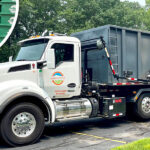BioCycle May 2015
Toronto, Ontario: “Zoo Poo” Digester Project Advances
The nonprofit ZooShare Biogas Co-operative Ltd. in Toronto recently announced that more than 300 local residents had bought out its $2.2 million (Cdn) “community bond” offering intended to partially fund construction of North America’s first zoo-based biogas plant. In fact, the offering was oversubscribed by $500,000, and those applicants have been put on a waiting list for possible further projects, says ZooShare’s executive director, Daniel Bida. The campaign to sell the bonds, which are to pay seven per cent annual interest for seven years, lasted 18 months, Bida adds. “The strategy was to rely on grassroots sales, and to lean heavily on people who had already bought in to help keep the momentum going.” Most buyers were baby boomers, over age 55, who have more disposable income than other groups, liked the financial return and, above all, had “a desire to leave a legacy.” The minimum investment was $500. Most were less than $10,000, but one individual, early on, bought $200,000 worth of bonds.
 The facility will include a complete-mix wet anaerobic digester that is to run on about 3,300 tons annually of manure from animals at the Toronto Zoo and about 15,400 tons of food waste collected and preprocessed by a major grocery chain. The chain plans to install equipment in each store to turn food wastes into a slurry that will be trucked to the digester and fed by hose into a buffer tank. From there, it can go into the single digester tank with no preprocessing other than pasteurization. The food waste contract runs for 10 years, with a renewal option for a further decade.
The facility will include a complete-mix wet anaerobic digester that is to run on about 3,300 tons annually of manure from animals at the Toronto Zoo and about 15,400 tons of food waste collected and preprocessed by a major grocery chain. The chain plans to install equipment in each store to turn food wastes into a slurry that will be trucked to the digester and fed by hose into a buffer tank. From there, it can go into the single digester tank with no preprocessing other than pasteurization. The food waste contract runs for 10 years, with a renewal option for a further decade.
Biogas from the digester will fuel a 500-kilowatt generator that will feed electricity into Ontario’s grid under a 20-year Feed-In Tariff contract, part of a provincial program that pays a premium rate for renewable energy. ZooShare expects that initially about 90 percent of the plant’s revenues will come equally from electricity sales and tipping fees, with the remainder from selling fertilizer products made from the digestate.
ZooShare is now awaiting project approval from the Ontario Ministry of the Environment, which it hopes to receive by the end of May. It will then complete selection of technology suppliers and arrangement of $2.6 million in debt financing to cover the rest of the $4.8 million construction cost, and a further $1.2 million in long-term debt. If all goes according to plan, construction will start in September, with commissioning completed by May 2016, Bida notes. A delay in the environmental approvals could push completion back to December 2016. He adds that odor control is critical, since the facility will be on the zoo property, a popular tourist attraction.
Bladenboro, North Carolina: Farm Digester Wins Engineering Award
The Storms Farm anaerobic digester installation, Storms Hog Power, earned a National Recognition Award from the American Council of Engineering Companies (ACEC). This Award honors projects that demonstrate exceptional achievement in engineering, explains ACEC. Storms Farm installed a 1.2 million gallon DVO Two-Stage Mixed Plug Flow™ anaerobic digestion system to manage manure collected daily from nearly 30,000 hogs. The manure previously was treated in open air lagoons. Storms Farm is using scrapers instead of flush water to remove manure from the hog houses. It processes off-site agricultural wastes in addition to its own manure. North Carolina Electric Membership Corporation purchases all of the 600 kW of electricity generated by Storms Hog Power under a long-term contract. The facility uses an engine generator and switchgear supplied by Martin Machinery Inc. and GenTec LLC.
Quincy, Massachusetts: Grocery Chain Breaks Ground For On-Site Digester
The Stop & Shop Supermarket Company LLC broke ground in April 2014 for the company’s first anaerobic digester, located at its Distribution Center in Freetown, Massachusetts. Food from its stores that goes unsold, or is unable to be donated to regional food banks or local farms, will be transported to the distribution center for anaerobic digestion. “Once operational, the anaerobic digester will create approximately 1.25 megawatts of clean, based load electricity, which would offset up to 40 percent of the Freetown facility’s energy use,” explains Jihad Rizkallah, vice president of responsible retailing for Ahold USA, Stop & Shop’s parent company.
The grocery chain continues its initiatives to reduce waste in stores and divert safe, consumable food to area food banks through its Meat The Needs Program. Through this program, Stop & Shop safely freezes, and then donates to food banks protein-rich meat that is pulled from sale before its sell-by date. The digester is anticipated to begin full operation by the first quarter of 2016.Stop & Shop has more than 375 stores in New England, New York and New Jersey.
Washington, D.C.: Renewables Leader In New Generating Capacity
According to the latest “Energy Infrastructure Update” report from the Federal Energy Regulatory Commission’s (FERC) Office of Energy Projects, wind, solar, geothermal and hydropower combined provided over 75 percent of the 1,229 megawatts (MW) of new U.S. electrical generating capacity placed into service during the first quarter of 2015. The balance (302 MW) was provided by natural gas. Specifically, during the quarter, eight new “units” of wind came on line with a combined capacity of 647 MW — accounting for 52.64 percent of all new generating capacity for the quarter. It was followed by 30 units of solar (214 MW), one unit of geothermal steam (45 MW), and one unit of hydropower (21 MW). FERC reported no new capacity from biomass sources for the quarter nor any from coal, oil or nuclear power. In 2014, renewable energy sources accounted for half of all new generating capacity in the U.S. It is important to note that generating capacity is not the same as actual generation. According to the most recent data (as of December 2014) provided by the U.S. Energy Information Administration, actual net electrical generation from renewable energy sources now totals 13.2 percent of total U.S. electrical production.
Nonetheless, renewable energy’s inroads are impressive. According to the FERC report, renewable energy sources now account for 16.92 percent of total installed operating generating capacity in the U.S.: Water is 8.53%; wind is 5.65%; biomass is 1.38%; solar is 1.03%; and geothermal steam is 0.33%. Renewable energy capacity is now greater than that of nuclear (9.11%) and oil (3.92%) combined. “The trend lines for the past several years have been consistent and unmistakable,” notes Ken Bossong, Executive Director of the SUN DAY Campaign. “Each month, renewable energy sources — particularly wind and solar — increase their share of the nation’s generating capacity while those of coal, oil and nuclear decline.”
Staffordshire, England, UK: Grocery Store Powered By Its Own Food Scraps
The Sainsbury’s grocery chain in the United Kingdom announced that its Cannock superstore in Staffordshire is the first to be entirely powered by the retailer’s own food waste. According to an article in Guardian Sustainable Business, excess food generated at the Cannock store that cannot be donated or fed to animals is sent to an anaerobic digestion facility in Cannock operated by Biffa. Biogas is used to generate electricity. The superstore is less than 1.5 kilometers (0.93 miles) from the Biffa digester, so the two companies decided to install a cable linking the biogas-derived power to the store. “The link means that the Cannock store can use renewable energy produced from Sainsbury’s own food waste, ending its reliance on the National Grid for day-to-day power supplies,” reports Guardian Sustainable Business. “The project involved an investment of around £280,000 ($426,000) for installation of power cables, switch gears and legal fees. Yet the retailer estimates that, in one year, it may save £140,000 ($213,000) in reduced energy costs thanks to the project.”
Koln, Germany: European Biowaste Ad Market To Double
Fueled by European Union waste legislation, Europe’s installed capacity of biowaste anaerobic digestion plants should nearly double, from 900 MWel in 2014 to around 1,750 MWel in 2023, says a new report from German research company ecoprog GmbH, based in Koln. Ecoprog interviewed energy agencies, public authorities and waste associations as well as operators and plant manufacturers, and found that the number of plants digesting municipal and industrial biowaste (separated organics) should jump from 800 to over 1,450.













